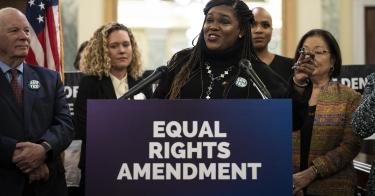Once again, Democrats are pushing to ratify the Equal Rights Amendment. They’re beating a dead horse.
Over the years, more than 1,100 resolutions proposing an Equal Rights Amendment have been introduced in Congress. Only one—House Joint Resolution 208, proposed in 1972—received the two-thirds support needed to be sent to the states.
That resolution had a seven-year deadline for ratification.
At least 38 states needed to approve the amendment, but, by early 1977, confirmations stopped at 35—and five of those states quickly rescinded their approval. The March 1979 deadline passed without additional approvals, as did an extended deadline Congress tried to set. As the Congressional Research Services puts it, the ERA “formally died on June 30, 1982.” Pretending otherwise makes a mockery of the legislative process.
>>> Not Your Grandmother’s ERA: Why Current Equal Rights Amendment Strategies Will Fail
But that hasn’t stopped some lawmakers. In March 2021, the House narrowly passed a resolution purporting to remove the 1972 ERA’s ratification deadline. Sen. Ben Cardin (D-Md.) has now introduced a similar measure, Senate Joint Resolution 4.
The 1972 ERA’s deadline, however, was valid and binding. When it failed in the states, it died. It is no longer pending before the states to be ratified, and no longer pending before Congress to be amended. It no longer exists.
The Supreme Court has held that Congress’s authority to propose constitutional amendments includes the power “to fix a definite period for the ratification.” Congress has done so many times. Eight amendments currently in the Constitution were ratified under a seven-year deadline, and nearly 60 resolutions to propose the ERA, including Resolution 208, have deadlines. Everyone, from Rep. Martha Griffiths (D-Mich.), who introduced the 1972 ERA, to the women’s groups promoting it supported including a ratification deadline and understood that it was valid and binding. In fact, that is the only reason they pushed to extend the deadline.
Congress proposes a constitutional amendment by adopting a joint resolution containing two parts: an introductory clause and the text of the proposed amendment. A ratification deadline can appear in either location. Looking at the Constitution, the deadline set for Amendments 18 and 20 through 22 appears in the text while the deadline for Amendments 23 through 26 appears in the introductory clause.
It’s unlikely that Congress will ever muster two-thirds support for another ERA resolution, so supporters are desperate to give the impression that the 1972 ERA is at least on life support. Thus, they now claim that a ratification deadline is valid only if it appears in the text, not if it comes a few inches up the page in the introductory clause. It just so happens that Resolution 208’s deadline was in the introductory clause, and so, they proclaim, it’s still alive.
This mischaracterizes, or perhaps misunderstands, both how Congress proposes constitutional amendments and how states ratify them. Congress does not vote on the amendment text in isolation, but on a resolution that includes that text, and sends that resolution to the states. Congress actually considered where to put a ratification deadline, the consensus finding the introductory clause more suitable for a very practical reason. Since a deadline is not important after an amendment is finally ratified, keeping it out of the amendment’s text helps avoid cluttering up the Constitution. Congress attributed no more significance to a deadline’s location than that.
>>> How Courts Would Use the Equal Rights Amendment to Ruin the Country
In at least 25 states, the legislature ratified the 1972 ERA by adopting a resolution that quoted Resolution 208 in its entirety, including the introductory clause and the ratification deadline. Other states made specific reference to the deadline during the ratification process. Congress knew when proposing, and the states knew when ratifying, that the deadline was valid and binding. Congress has the authority to set one, and its relative placement in a proposing resolution has no relevance whatsoever.
The unavoidable conclusion is that the 1972 ERA died no later than June 30, 1982. Like a resolution that expires when the Congress in which it was introduced adjourns, the 1972 ERA expired when its deadline passed with fewer state ratifications than the Constitution requires.
Pretending that Congress has the power to extend the time limit for a failed constitutional amendment that has not existed for more than 40 years is absurd. ERA supporters should instead follow the advice of the late Justice Ruth Bader Ginsburg.
As a law professor in 1977, Ginsburg drafted a report for the U.S. Commission on Civil Rights acknowledging that the 1972 ERA could become part of the Constitution only if ratified within its original seven-year deadline. Forty-three years later, as a justice, Ginsburg said that ERA supporters should “start over.”
This piece originally appeared in The Hill on 02/06/2023




